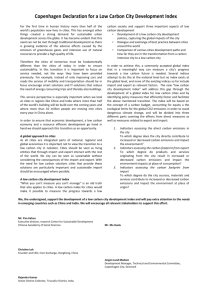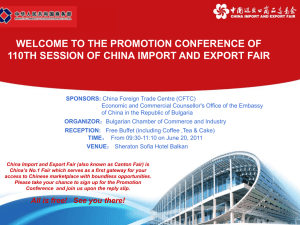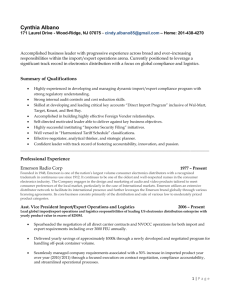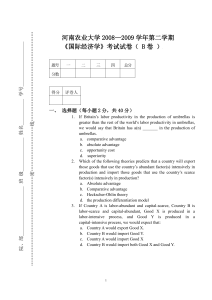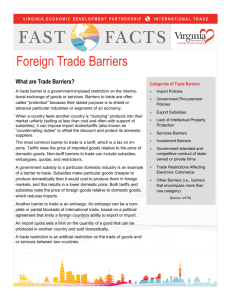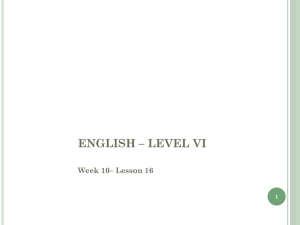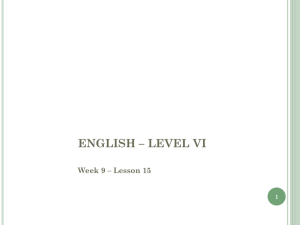International Trade
advertisement
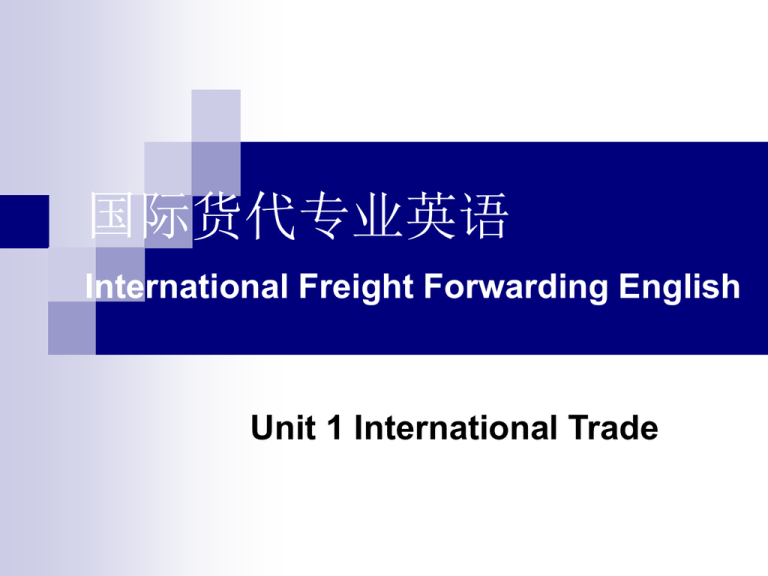
国际货代专业英语 International Freight Forwarding English Unit 1 International Trade Unit 1 International Trade Teaching Objectives: To grasp the related the technical forms; To understand the general information of international trade; Teching procedures: 1. 2. 3. 4. Background information introduction and warm-up discussion; New words and expressions; Text learning( questions and answers+ difficult points explanation; Practice and exercises. 1.Background information 背景知识 国际贸易:货物贸易 技术贸易 服务贸易 定义: 国际贸易是指世界上各国(地区)之 间进行的商品和服务的交换活动。 概念区分: Foreign trade对外贸易 Internationa trade国际贸易 国际贸易的分类 按货物移动方向: 出口贸易(Export Trade) 进口贸易(Import Trade) 过境贸易(Transit Trade) 按商品形态划分: 有形贸易(Visible Trade) 无形贸易(Invisible Trade) 按贸易是否有第三国参与划 分: 直接贸易(Direct Trade) 间接贸易(Indirect Trade) 转口贸易(Transit Trade) 按贸易参加国的数目划分: 双边贸易(Bilateral Trade) 多边贸易(Multilateral Trade) 国际贸易的特点 1. 是一项具有涉外性质的 商业活动: 经济利益、涉外活动 2. 贸易环境错综复杂,变 化多端: 不同的政治制度、法律体系、文化背景、价值 观念等 3. 风险远比国内贸易大: 距离远、自然灾害、意外事件、国际市场情况、 恐怖、海盗 4. 线长、面广、中间环节 多: 商检、仓储、运输、保险、金融、车站、港口、 海关等部门 5. 竞争异常激烈: 商品、市场、技术、服务质量等 Warm-up discussion 1. What is international trade? What is foreign trade? 2. Why should we learn international trade before we learn international freight forwarding? 2. New words and expressions生词与表达 Gross Domestic Product(GDP) 国内生产总值 Outsourcing 外包 Factors of production 生产要素 Multilateral trade 多边贸易 The International Monetary Fund 国际货币基金组织 The World Bank 世界银行 Important uses Multi-: pref. 表示“多,多种,多个”之义 e.g multinational 多国的,n.跨国公司 multicultural (融合、具有)多种文化的 multilateral 多边的 multiplication 增加,乘数,乘法运算 专业特性的词汇: offer: 提议,提供 order:命令,订购 customs clearance quotation 引语,引用 出价 订购,订单 报关 报价单,行情表 Labor-intensive 劳动密集型 知识密集型 :knowledge - intensive Text: 1.Definition What is international trade? It is the exchange of capital, goods, and services across international borders or territories. 2. Importance of International Trade 1. It is crucial to the continuance of globalization; 2. It is a major source of economic revenue for any nation that is considered a world power. 3. Without international trade, nations would be limited to the goods and services produced within their own borders. 3. Differences between International trade and Domestic Trade Key words: costly more mobile 1. International trade is typically more costly than domestic trade. Why? additional costs: tariffs, time costs, country differences 2. The factors of production are typically more mobile within a country than across national borders. 4. Risks in International Trade Economic risks: 1. insolvency; 2. failure to pay the amount; 3. non-acceptance; 4. exchange rate, and so on 1. 2. 3. 4. 5. 6. Political risks: Cancellation or nonrenewal of export or import licences; War risks; Risks of expropriation or confiscation of the importer’s company; Risk of imposition of an import ban after the shipment of the goods; Transfer risk; Influences of political parties. 5. WTO: World Trade Organization Four basic functions: 1. to implement, administer, and carry out the WTO agreement and its annexes; 2. to act as a forum; 3. to serve as a tribunal; 4. to review the trade policies and practices of member states. Additionally, WTO is to cooperate IMF and World Bank. 6. Barriers to Internation Trade What is a trade barrier(贸易壁垒)? A trade barrier is a general term that describes any government policy or regulation that restricts international trade. Including: import duties import licenses, export licenses, import quotas, tariffs, subsidies and non-tariff barriers to trade 7. Steps of International Trade Seeking customers Contact each other by sending inquiries Status inquiry Quotations or offers; acceptance or non-acceptance Order; contract Obtaining import / export license; opening L/C / receiving L/C, if any Preparation of goods by the seller Inspection or survey of goods Reserving shipping space either by the seller or buyer, depending on the trade terms Effecting insurance Customs clearance and loading Shipping advice Negotiation of exprot documents under L/C by the beneficiary Redemption of documents under L/C Customs clerance for import Delivery of goods Lodging and settling claims (if any) 7. Practice and exercises Write “T” for true and “F” for false. 1.If two nations repeatedly use trade barriers against each other, it is beneficial to both nations. ______ 2. A trade barrier is really a barrier that makes it difficult for people to do business between nations. _______ 3. In international trade, both political risks and economic risks are involved. ______ 1. 多项选择题 Many factors are having a major impact on the international trade system. They are Industrialization, advanced transportation, _____, multinational corporations, and _____. A. outsourcing B. globalization C. domestic production D. labor force 2. Costs associated with countries such as___, ____ or a different culture may make international trade more costly than domestic trade. A. / B. language C. legal system D. political difference 3. When we talk about the factors of production, we refer them to such factors as _____ . A. capital B. labor C. technology D. information 4. Economic risks include ______. A. the risk of insolvency of the buyer B. the risk of failure of the buyer to settle the payment C. the risk of non-acceptance D. the risk of exchange rate 英译汉 Gross domestic product Labor-intensive goods International finance The International Monetary Fund Multinational corporation Inspection of goods Lodge a claim Reference answer 国民生产总值 劳动密集型产品 国际金融 国际货币基金组织 跨国公司 商品检验 提出索赔 汉译英 生产要素 进口许可证 世界银行 清关 舱位 发盘 出口关税 多边贸易 世界贸易组织 贸易壁垒 Reference answers factors of production import license the World Bank customer clearance shipping space make an offer export duties multinational trade World Trade Organization a trade barrier Thank you!
